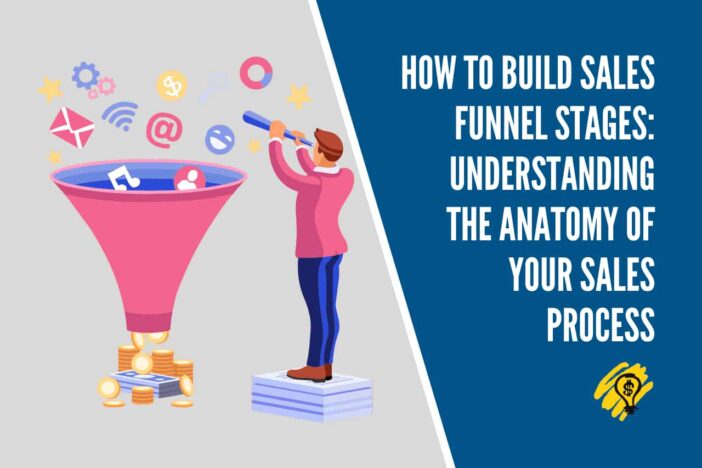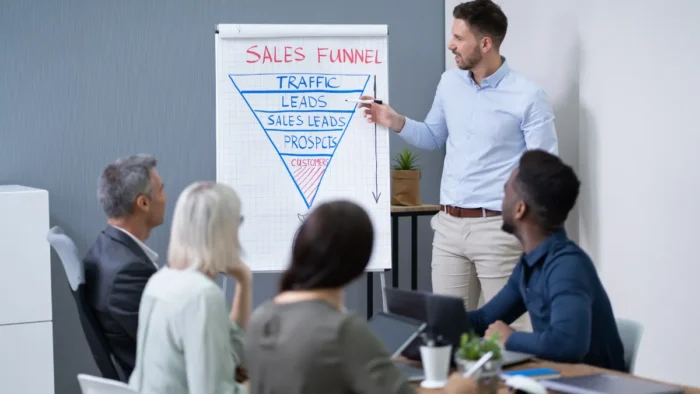If you want to sell more, you need to understand what your customers want. You need to build a sales funnel that moves people through your sales process as smoothly and effectively as possible.
There are several stages in a funnel, and if you want to build an effective sales process, you need to understand what each stage is and what they do. This will give you a framework to help you identify and implement the optimal sequence of steps to ensure you move as many prospects through your funnel as possible.
More customers will bring more income to your company. But, the most significant challenge is to succeed in developing and using a sales funnel that will enable the continuous flow of customers from the beginning to the end of the funnel.
The sales funnel can be seen as the lifeblood of any business — and it’s essential to understand how to build each funnel stage. Here, I want to share a helpful but straightforward process that you can use to develop your funnel stages.
1. What is a Sales Funnel
The funnel simply is a graphical representation of your business’s sales process. While the basic concept behind the funnel is simple, the real beauty comes from its ability to visually show the entire journey from visitor to consumer. It’s also beneficial for making sure you’re using all the resources in your sales funnel.
The funnel is comprised of stages within stages that represent a progression of the customer’s journey towards purchasing. This is important to understand because this is how potential consumers will see your company, and it’s also how you’ll sell and ultimately close deals.
Each stage in the sales funnel has different objectives. Each funnel stage should also be split into distinct and measurable steps. I’m going to teach you how to build your funnel step by step so that you can achieve your goal of becoming a profitable entrepreneur.
The basic idea is that the prospect begins at the top of the funnel, moves through various stages, and ends at the bottom of the funnel, ready to purchase your products or services. Different variations on the traditional funnel include multi-stage funnels and even more complex funnels that look like fractals.
For example, a prospect who comes to your site might not buy anything. However, they may still be interested in what you have to offer, especially if your site is engaging and offers a solution to a problem. So, to drive them toward making a purchase, you need to direct them down the right path. This is what a funnel is designed to do.
2. Why You Need A Sales Funnel
One of the reasons entrepreneurs struggle to convert awareness into customers is that they fail to fully understand converting prospects into paying consumers. Some marketers think they have a solid sales funnel when in reality, their funnel is more like a river. Because the steps are in a series, they don’t represent a defined action but a general direction.
Without a funnel, it can be challenging to track where your customers come from, where they go after buying, and how they ultimately purchase your products.
If you don’t have sales funnel, how do you know what to do next? How do you figure out how to get potential customers to buy?
This is one of the most powerful tools to increase sales and improve conversions. It can help you build relationships with your ideal consumer. Because the funnel is based on the premise that “people don’t buy products, they buy solutions to problems,” they’re often used in conjunction with conversion optimization.
3. Types Of Sales Funnels
There are three different types of sales funnel models:
Linear
In a linear model, the sales process begins with a prospect or lead and flows through all stages in sequence until the sale is complete. The goal of each step is to capture the attention and conversion of your potential customer and move them along the path to purchase.
This model is pretty straightforward. It’s based on a single step, the “first impression” stage. This is where you make the first contact with the potential customer. You could do this through an email, social media message, phone call, or some kind of interaction.
Once this contact is made, the prospect moves to the next stage. This is when he will become more familiar with your business. From there, they move to the third stage: the product or service being sold. They’ll buy from you if they think they’re going to be satisfied.
There are typically three basic steps along this path: awareness, interest, and, finally, a sale. These are the three steps a customer goes through when they become aware of your product, are interested in using it, and make a purchase decision.
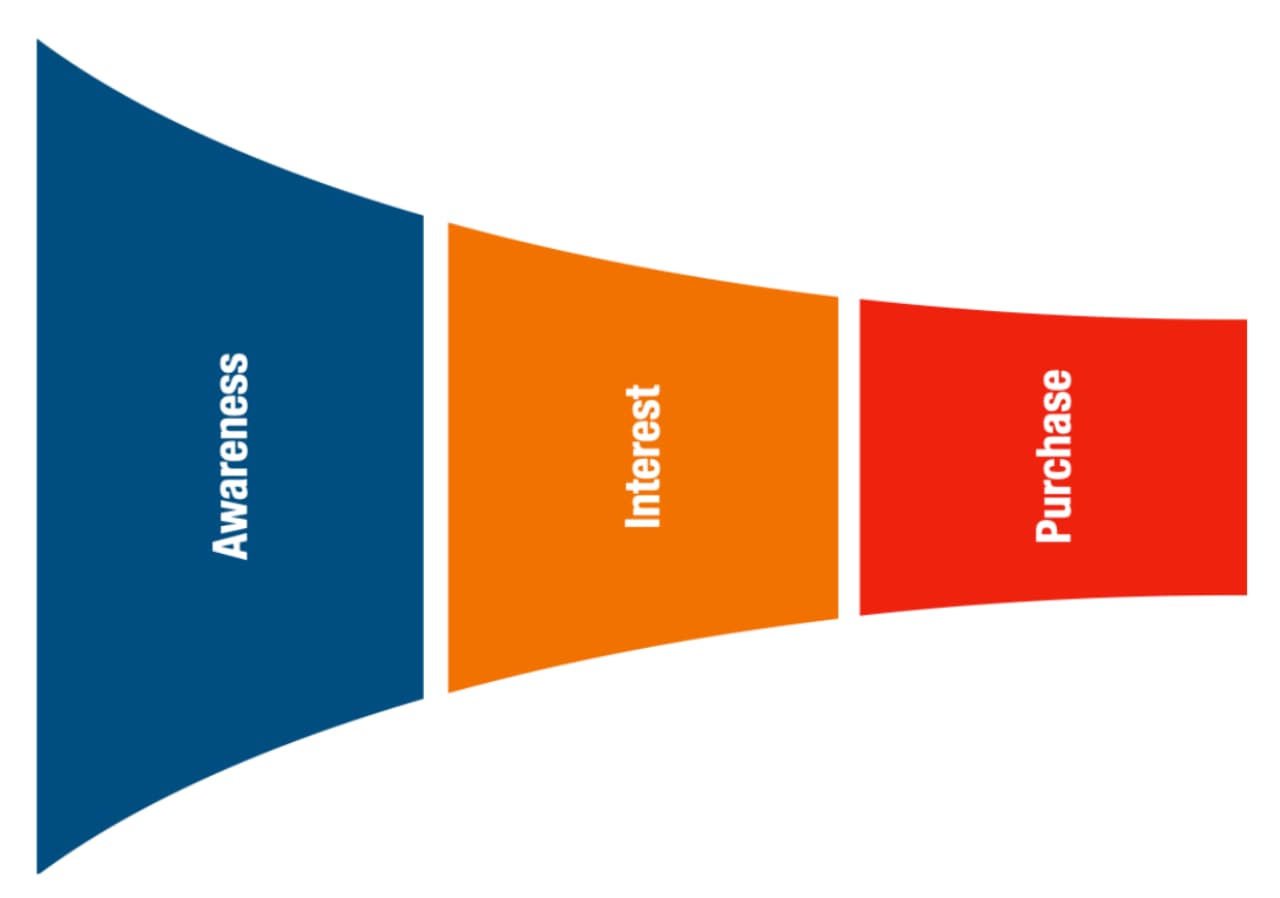
Awareness happens when the prospect finds you, sees your product or service, or reads about your brand.
Interest happens when he wants to know more and learn more about your product or service.
A sale happens when he decides to take action and is ready to buy.
Multi-stage
In a multi-stage model, the sales process occurs in multiple stages, but the order in which the stages occur can vary. A multi-stage funnel can include anywhere from two to 10 stages.
For example, a prospect might begin by searching Google for a specific product, only to be shown an ad that leads them to a landing page. The landing page links them to a page that offers a free sample of the product and then to a checkout page that allows them to buy the product.
Related: 8 Ideas to Help You to Create Your Own Sales Leads Databases
This model gives companies a way to structure their sales process and target customers’ needs throughout the funnel.
A multi-stage funnel will help you to group customers into categories and focus your attention on each category. Each stage is a group of customers, and each group is a different sale. A multi-stage sales funnel allows you to target different groups of customers who you know share a similar interest or need. In such a way, you’re able to tailor content and messages for each stage of the customer’s journey, and you’re able to use retargeting to nudge your prospects further along the path.
So, the path through the sales process is broken into discrete stages. The process progresses through those stages in a series of sequential but overlapping steps that give customers a chance to engage with your brand at each stage of the process.
Related: How to Develop and Improve Your B2B Sales Processes
Cyclical
A cyclical funnel shows the steps a potential customer goes through to become a customer. It looks like this: awareness, interest, purchase, keep customers, more sales to existing customers, and referrals.
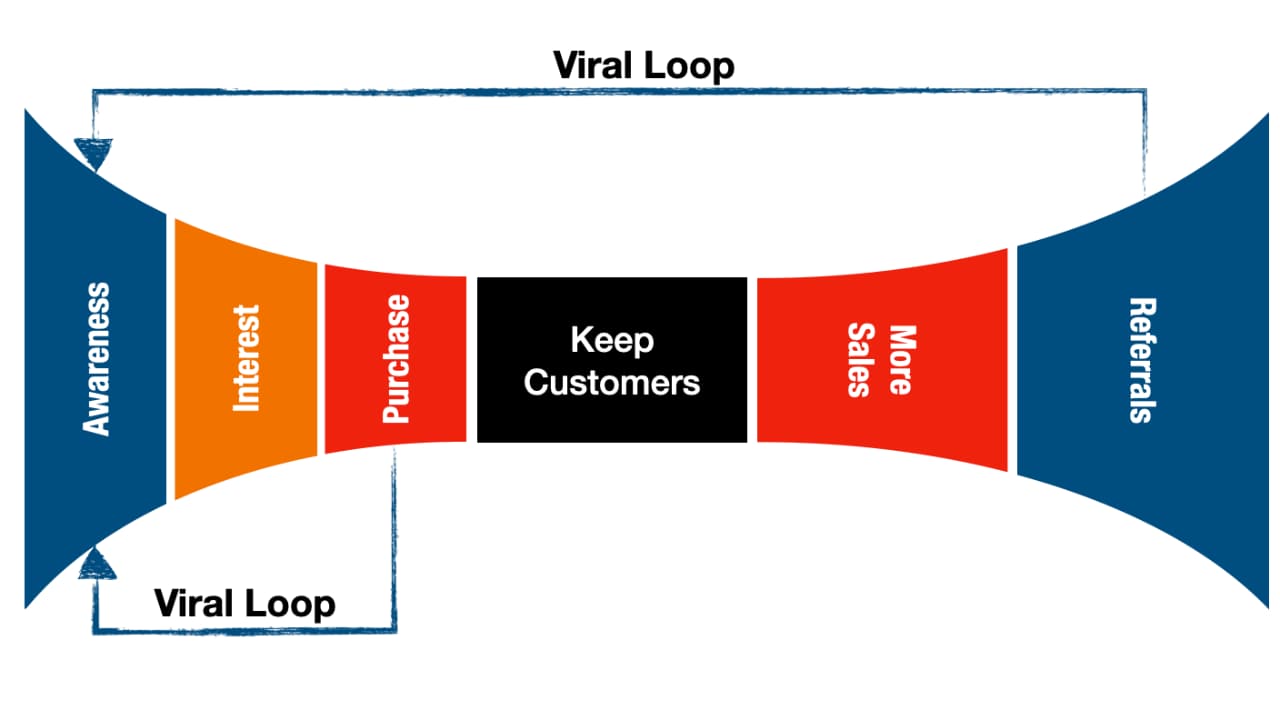
As you can see, once a customer converts to being a loyal customer, that customer is more likely to convert again and again. But, it is not the end of the process. You want your customers to become your biggest promoters using the referrals program. They are an essential part of the sales funnel.
For example, a simple version of this would be:
- Be aware of product and service
- Know more and learn more about your product or service
- Buy the product or service
- Repeat the purchase
- Buy more other products and services
- Write a review
- Recommend the product or service to other people
- Share on social media about the product and service
- Write a blog post
- Buy another product or service
- Repeat the steps from 4 to 8
You can see through this example why this is a cyclical funnel. It is a cycle that will never stop, and you are using your current customers to sell more to them and like the biggest promoters for your products and services.
Related: How to Have Multiple Phone Numbers on One Cell Phone: A Step-By-Step Guide
4. Sales Funnel Anatomy
You can look at funnels like assembly lines for your sales process.
To understand how to make the sale, you need to understand the anatomy of the funnel.
The funnel anatomy diagram illustrates a sales representative’s steps from the initial call through the closing sale. It can be used as a template to guide salespeople and marketers to develop a lead generation process strategy and plan the follow-up activities to ensure conversion to the next stage in the process.
As we already talk regarding the linear sales funnel, we have three stages: awareness, interest, and purchase. There can be different variations in these stages. For example, sometimes, we can use awareness, interest, desire, and purchase. But, it doesn’t matter how we present it here because you will develop the proper stages specific for your company.
Let’s talk about all the stages you need to take into consideration.
Awareness stage
You have already spent your time and money to bring prospects inside your sales funnel. Now is the right time to make them aware of the solutions you can give them. It is not enough only to pay for advertising and to think that your prospect is already aware of how you can help him.
The awareness stage of the funnel is all about education. People are aware of the need for the product and service but don’t yet fully understand how to use it or why it’s a good idea for them. It’s a key phrase because until the potential customer knows why they should be using a new product or service, there’s no real point in buying it. Once the potential customer understands how the product or service will benefit them, they’ll be more likely ready to go into the next stage – to be interested in your solutions.
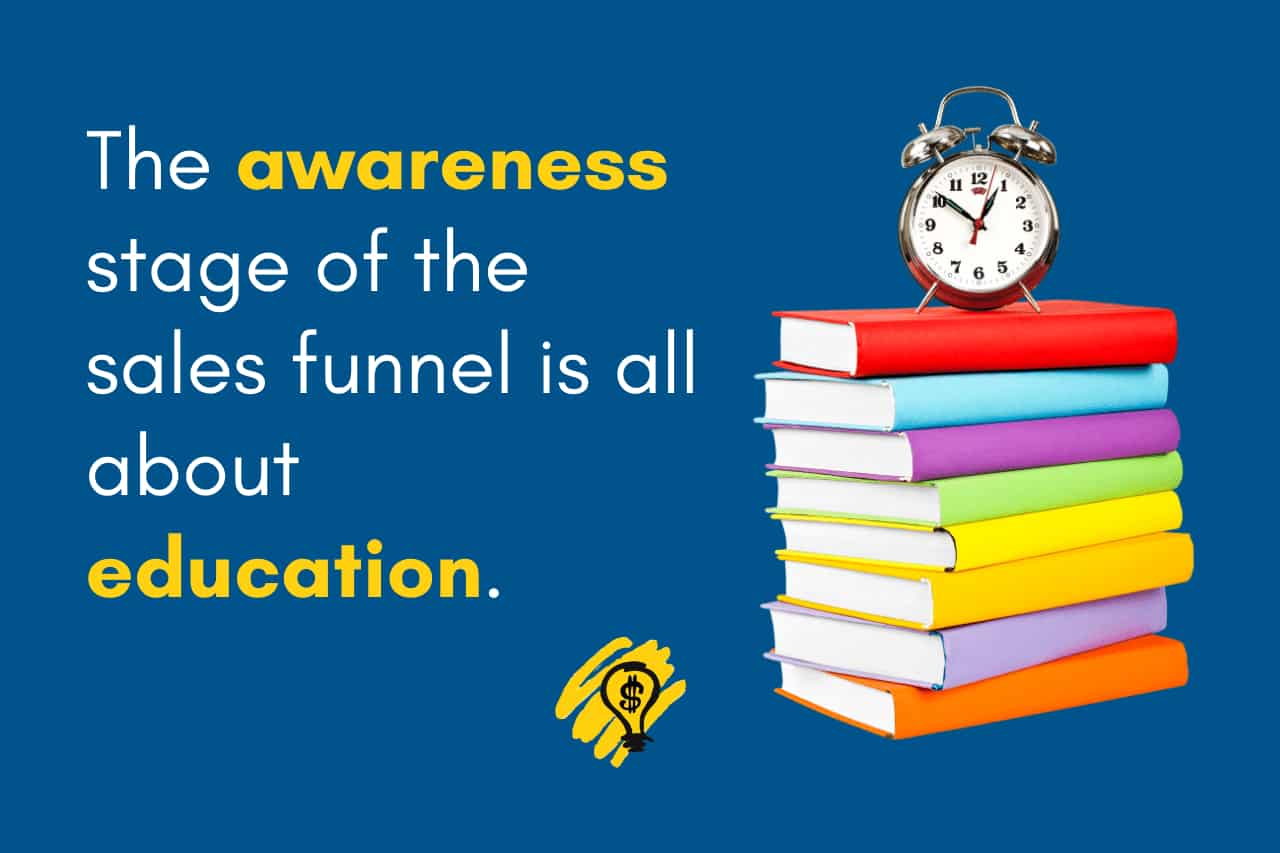
You must tell your audience why they need your product or service at this stage. You need to explain why they should buy it. Also, you need to convince your potential customers to buy your products or services.
People are willing to spend money on your products and services because they know the benefits. They need to know why they should buy it. Tell them why they should buy it and how they will benefit from it.
Interest stage
In the interest stage of the sales funnel, customers are still interested in a product but don’t feel ready to make a purchase. Your objective should be to help them move past the “just curious” phase in the interest stage. The best way to do this is by creating a sense of urgency around your offer.
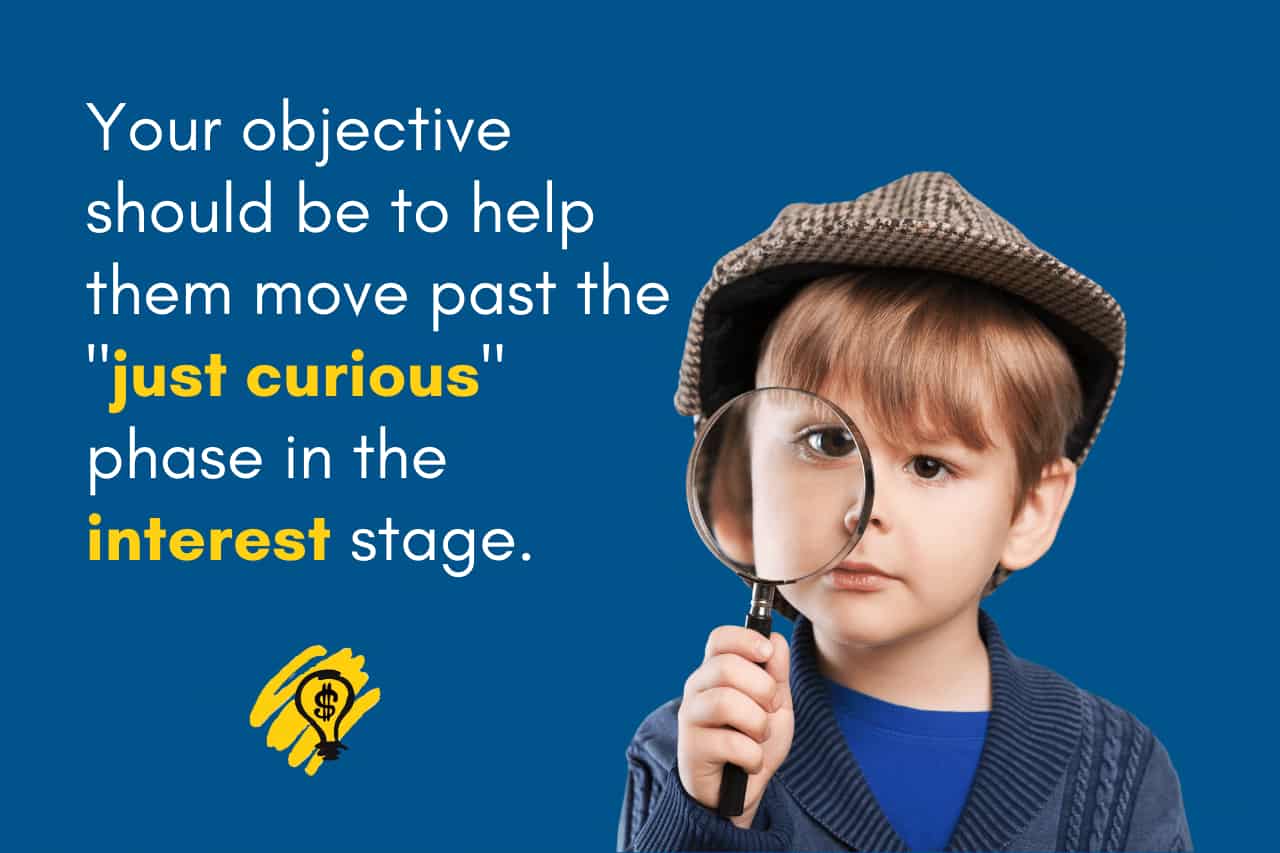
Here, the customer is still evaluating whether the product or service will be worth the purchase price but is willing to hear what the salesperson says. He is more open to new information and wants to feel like he is making a good decision.
The primary purpose of this phase is to find a way to get prospects interested in your product or service.
How do you do that?
First, let’s think about what we mean when saying “interest.” There are two ways to describe this interest: the psychological interest, which describes what people feel and how they behave at the moment, and the economic interest, which is how people act when they want something more than anything else.
So, to be interested, you have to feel some emotion, like desire or curiosity, and then act on that feeling by asking yourself questions that will elicit a response.
Purchase stage
The purchase stage is defined by the point at which the customer is ready to make the purchase and start working towards it.
Here you’re trying to convert the prospect into a customer, and you’re doing that by persuading them to take action – most likely buying your product or service. We call it the purchase stage because it’s when the prospect is either committed or uncommitted to buying your product.
According to this model, the more information a potential customer has, the higher will be their willingness to spend money.
Keep customers stage
One thing about a customer’s journey that seems under-appreciated is that there is no endpoint. This is one of the most significant disadvantages of the linear sales funnel.
If you want to increase the frequency at which someone buys from you, you need to keep them engaged with your brand long after they’ve purchased from you. The best way to do that is by offering a customer a reason to stay as a buyer in the middle of your funnel.
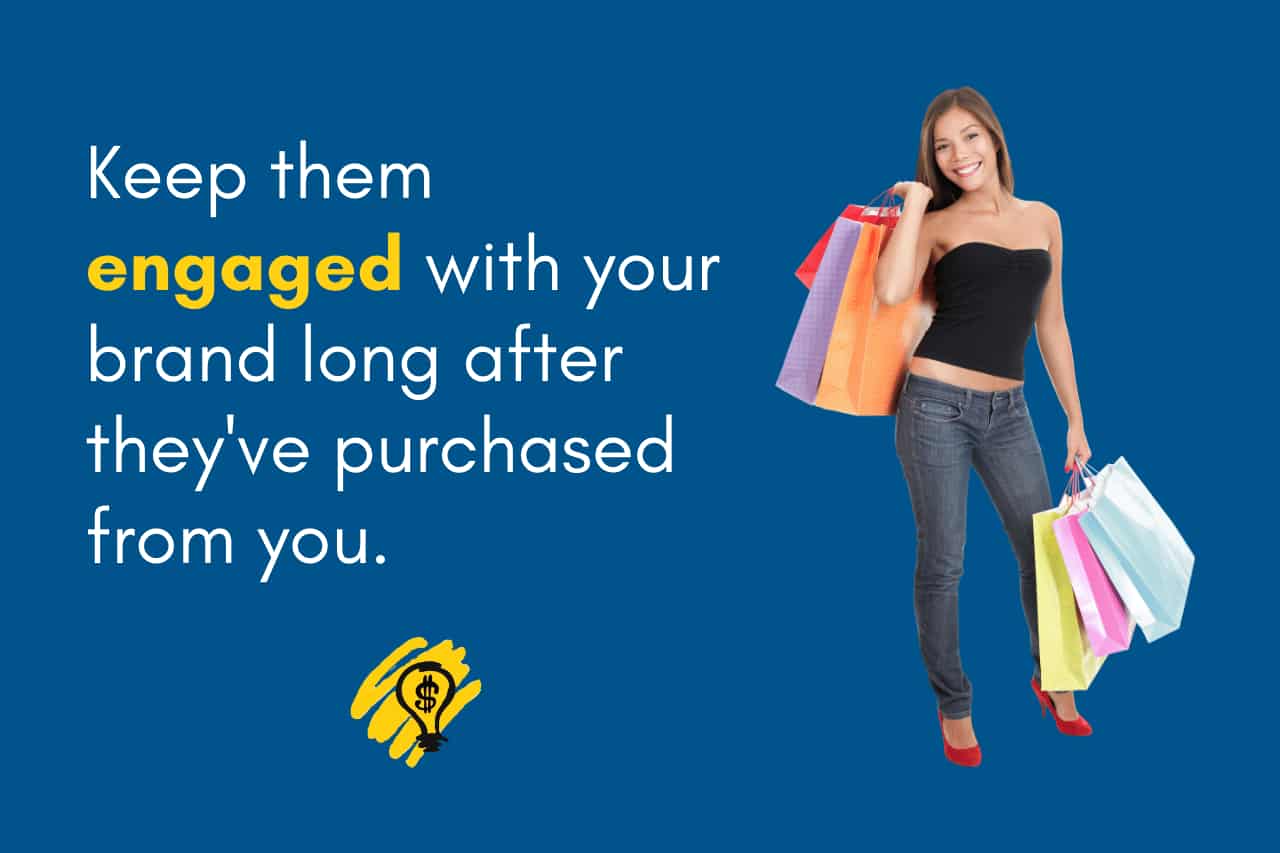
You want your sales process to be designed to retain customers and keep them in the funnel longer. You can achieve this when you include some steps that help keep your customers happy with your brand, and it needs to include some steps that make them feel like they’re being given special treatment and getting the best deal possible.
Use different loyalty programs and product updates. Also, you can use your blog and email to engage with customers when they are in this stage of your sales funnel.
Additionally, you can use some tactics to help customers promote your product and services to their community.
More sales stage
The purpose of this stage is to increase the monetary value of your customers. This means having a higher average income from each of your customers. For example, if they spend $100 on average monthly, you want to get $150 on average in the same period.
So, this is an essential part of your sales funnel. Many times we underestimate this stage, or in many cases, I have seen that there is not such a stage inside the funnel.
What can you do here?
Here are some strategies you can use to increase the monetary value of your customers:
Up-sell
At the up-sell stage, the customer is faced with a decision between purchasing a higher-priced version of the same product or a different, perhaps better, product. Up-sells aren’t just about additional products. They can also include services, new packages, upgrades, or other ways to extend the customer relationship.
Next-sell
Next-sell is when you try to engage with a customer who has purchased a higher-priced version from the previous stage.
To sell more, you first need to follow up with a buyer after the purchase with an exclusive offer. When you follow up with buyers after the purchase with an exclusive offer, you give them a second chance. You make them feel special, letting them know that you care about them.
Cross-sell
The cross-sell stage of the sales funnel is designed to encourage customers to buy additional products and services from your business. If you’re offering a product that is complementary to what a customer has already purchased from you, there’s a higher probability of the customer making a second purchase.
By offering complementary products to existing customers, you’re encouraging your customers to spend more money with you.
Referrals stage
The next step is to refer others to the company. A referral program is an act of offering rewards or incentives to someone else who refers new customers or clients to your company.
Referrals do generate prospects and can help you grow your business. It’s a proven fact that people like to share their good fortune with others, so it only makes sense that those people would be willing to let others know about you.
Referrals can have a massive impact on your overall business growth. Referred customers tend to spend more money on your product than other customers. They believe more in their friends who send the referral than in your advertising campaigns.
Here are some simple steps you need to take to build and implement a referral program for your company:
- Define your referral program goals
- Offer something special for your referral partners
- Make sure you keep your program simple
- Decide how you will track your results
5. Why Your Sales Funnel is Broken
There is always a chance that a new potential customer will enter your sales funnel, read one of your blog posts, see an ad, etc. Then they will move through the funnel. But not all of them will come until the end. If nothing happens from your efforts to move your prospects through the funnel, it means that it is broken. It doesn’t do the job that it will need to do.
So, why is your funnel broken?
The customer would decide to purchase your product or service right away in the ideal world. In reality, however, many people take the next step after seeing your product or service – they sign up for your email list, share your content on social media, etc. The result: you end up with many potential customers who aren’t ready to make a purchase decision.
When you consider the fact that almost half of your prospects won’t even take the first step in your funnel, it makes you wonder why it is that. One thing’s for sure – if you want to start closing more deals, you’ve got to fix the broken part of your funnel.
One of the reasons can be that you tend to focus more on getting customers into your funnel instead of ensuring they stay there and then converting them at the purchasing stages. The reality is that most companies spend a lot of money on marketing, advertising, or events without realizing that most customers don’t convert from cold leads to warm prospects.
Here are some steps you can take to fix the broken parts of your funnel.
Where is the problem?
The first step is to figure out which part is broken. The problem with your funnel is that it doesn’t work the way you planned. You’ve set up the funnel so that people have to pass through several stages before they buy. But, you don’t know whether your funnel works the way you think it does.
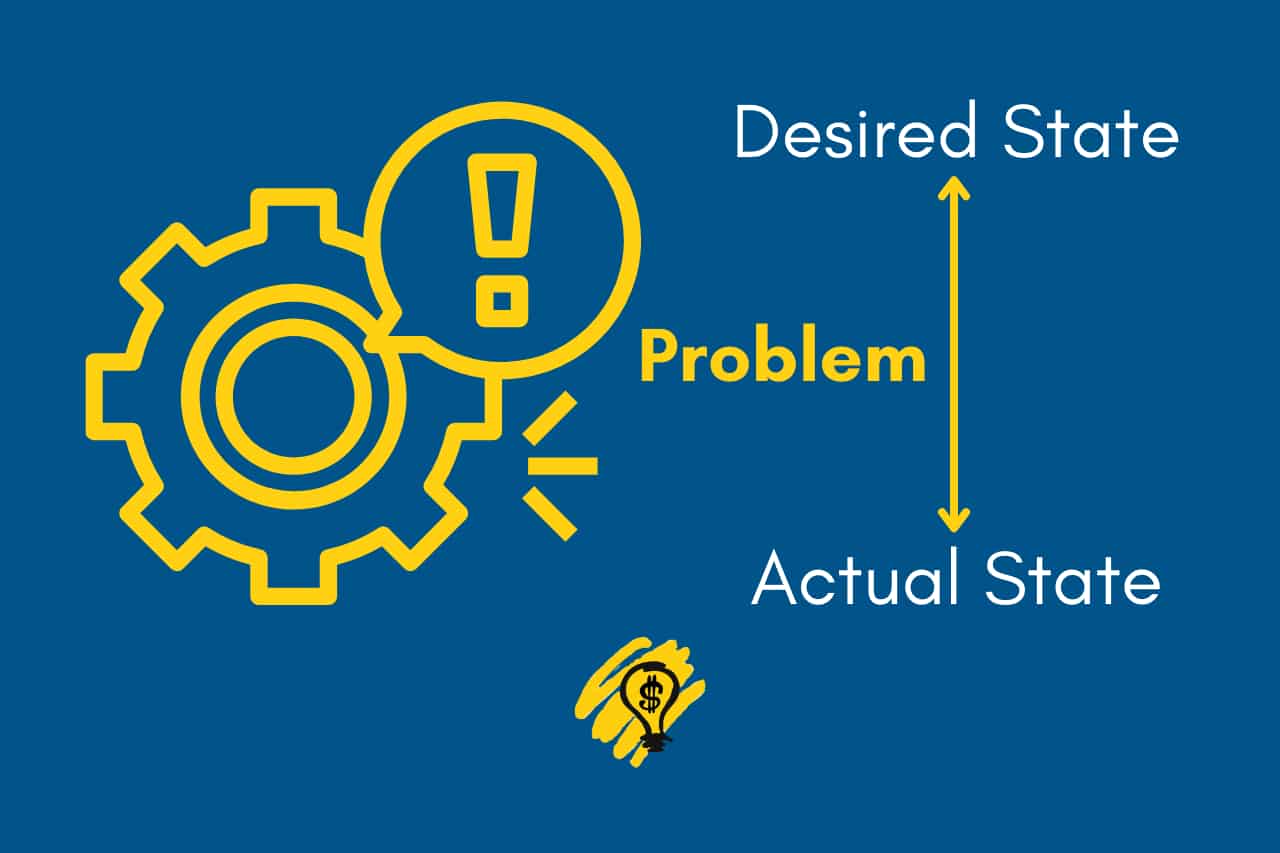
It is possible that your sales funnel is not functioning correctly for the following reasons.
- Your prospects are not converting to customers.
- You have a lack of information about your customers.
- You lack marketing material that will attract customers to your business.
Here you will need to understand where people fail to move forward through your funnel.
What is the solution to the problem?
The second step is to find a solution. Once you have identified the problem, you need to develop a solution to fix it. Your solution needs to be effective.
For example, maybe the reason for your failure is that you are not providing enough value to your customers. You can fix this problem by doing whatever it takes to provide more value. You can also improve the overall quality of your product. Or, you could use a different method to sell your products.
Test and implement the solution
The third step is to implement the solution that you’ve found. It’s not enough to just come up with a solution. You have to implement it.
Finally, you must test the solution. You can try implementing it in a small way and then expand it in the future. This can help you to see how well the solution works. If the solution works, then you can continue to use it.
6. Sales Funnel Build, Measure, Learn and Improve Loop
Until now, you have already built your first sales funnel. So, now is the time to go through a series of experiments, measure the results and learn what you need to improve.
So, using the Lean Startup principle of build, measure, and learn Loop, you can implement a continuous improvement process inside your funnel.
This is critical for creating anything worth building, including marketing campaigns. Whether you’re trying to learn something new or perfecting a process, you have to build, measure, and adjust based on the results of your tests.
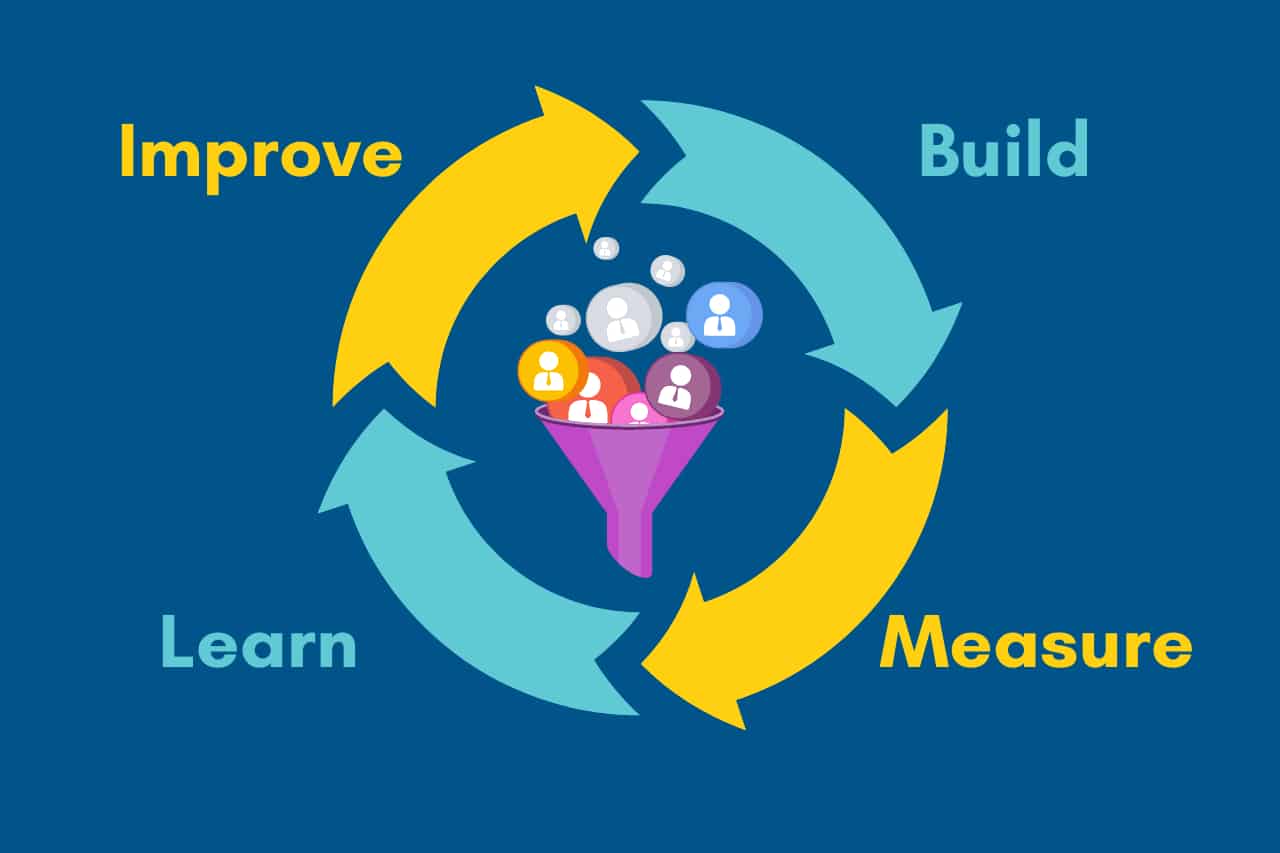
Build-Measure-Learn is a three-step process:
- Build your funnel.
- Measure the outcomes using data-driven insights.
- Learn what you’re doing well and where you need to improve.
When the measurement shows that something isn’t working, you should then be able to learn what you’re doing wrong and make adjustments inside your sales funnel accordingly. Don’t worry. We will go through examples until the end of this article, so you will understand what you need to do.
To implement this process, you need to follow these steps:
Build Your Sales Funnel
Let’s break down the whole “build” process, so you can follow a step-by-step approach to build your funnel.
1. Define Your Target Market
You can’t start developing something related to your customers if you don’t know who your customers are. So, before doing anything else, start describing your target customers because it will help you in the following stages of the process.
Yes, start putting your foot in the customer’s shoes. You need to start with the customer’s perspective. Try to develop unique sales funnel with the stages that will reflect the reality in and around your company.
If you want to start brainstorming possible funnel stages, work on answering the following questions:
- What do your target customers really want?
- What do your target customers need?
- Where are they?
- What type of problems are they having when buying something you are selling?
- How do they buy when they are in the purchase mode, and what is their behavior when they aren’t in the purchase mode?
- What are they doing when they are where they are?
- How do they want you to approach them?
- What is their biggest interest?
As you can see, the answers to these questions will lead you to the possible sales process. Answers to these questions will tell you more about the funnel stages you need to design and develop.
The output of this step will need to ensure that you:
- Understand your customer’s journey;
- Understand your prospect’s pain points
- Have designed a customer’s journey that starts with pain points and ends with pleasure.

2. Think Outside the Box
A unique sales funnel can’t limit itself to a specific industry or the market. If you want an innovative funnel that will bring you the income you want to achieve, it will ask you to be different from other industry or market participants.
So, start thinking outside the box, with an open mind for ideas and proposals from everywhere and from everyone. In such a way, you will be able to develop your own unique sales process that will be the basis for the future stages of the funnel.
3. Develop a Unique Sales Process
When you know your target customers, you have enough knowledge about them. You have collected and analyzed different ideas from inside and outside your company, market, and industry. Now, you can just start to design your sales process.
Start with the general stages that will be part of the process. You can put on paper everything that you have done from the previous steps that I am describing in this post. Then start drawing a diagram with all relationships between different stages in your sales process.
4. Start Developing the Funnel With All Stages
You need to know that your sales process will reflect the form and the stages of your funnel. So, the last thing is to start explaining your whole sales process in the form of the funnel and its stages.
Your funnel will clearly visualize the stages and specific metrics related to conversations between stages. In such a way, you will quickly be in a position to discover possible elements of the sales process that will need to be improved. When you locate and improve them, you will improve the overall income your company will generate.
Measure the outcomes
Every business wants to maximize the return on investment in marketing, but that return needs to be measured. That means taking an objective look at every aspect of the marketing process, from landing pages and ads to lead generation and conversion rates. The key to tracking all these steps is to set up specific goals and KPIs for every stage of the funnel – and that includes measuring the success of prospect nurturing and conversion rate optimization.
For example, let’s say that your main goal is to increase conversions. How will you measure this? That is easy by setting up a specific number that you want to hit. If your number is 10% higher than last year, you will be happy. If it is lower, then you need to change something.
Here are the steps you will need to take to systematize this process:
1. Set up KPIs
A Key Performance Indicator (KPI) is a measurement tool used to measure the performance of a business. It shows if the company is doing well or not. One important thing to note about KPIs is that they are very specific. It’s not good to use KPIs for general things. You should be very specific with them.
You should set up KPIs for all of your funnel stages. For example, your lead generation strategy should include the number of prospects you want to generate in a month. Your sales strategy should include the average price of each order.
Here are some KPIs that you should create based on the most important metrics of the sales funnel:
- The number of leads generated per period: This is one of the main KPIs you should set for your funnel. You need to respond to how many prospects I have generated in a specific period.
- Overall conversion rate: This is the ratio between the number of prospects that enter your sales funnel and the number of prospects that become customers.
- The conversion rate between stages: What is the conversion rate between awareness and interest? What is the conversion rate between interest and purchase?
- Average sale per customer: How much money you generate on average from each purchase. This is an essential KPI because it will help you compare it with the marketing budget you spend on generating prospects.
- Time required for each order: How much does it take on average for one prospect to be converted into one customer?
- Referral participation rate: It takes effort, but this is a great metric to track if you’re trying to get the word out. The higher the rate, the more referrals you’re getting.
Here is an example of KPIs inside the funnel matrix.
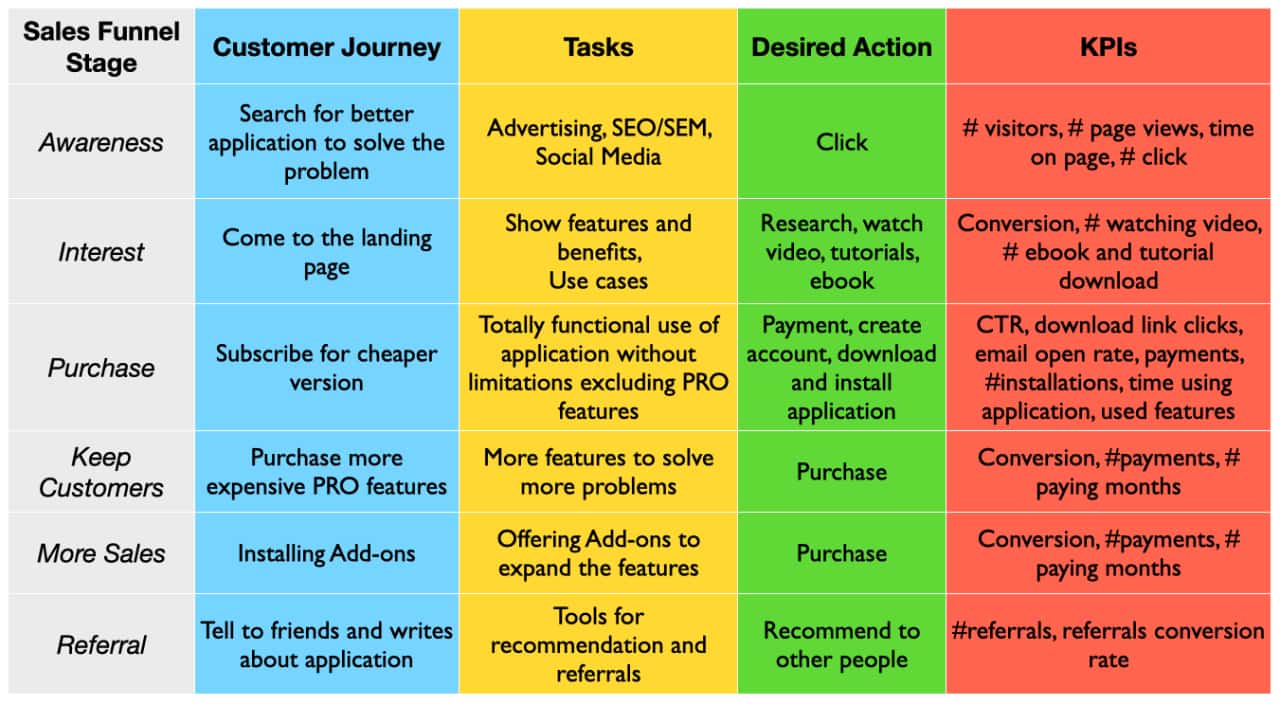
2. Setup the goals regarding each KPI
A good sales funnel allows you to set up a series of goals that measure the success of your marketing activities. These goals should include metrics based on the goals and objectives set out by the business itself. The primary purpose of the goals is to allow the business to evaluate the success or failure of its marketing efforts and help drive a continuous improvement in the effectiveness of those efforts.
The goals you set regarding each of your funnel KPIs will help you evaluate whether or not you are reaching them. They will need to allow the achievement of the overall sales goals.
For example, if you want to increase your profitability by 10% and know your profit margin, you can quickly go back from the end of the funnel until the first stage and set up a goal for each stage.
Here is an example of the sales funnel matrix with goals.
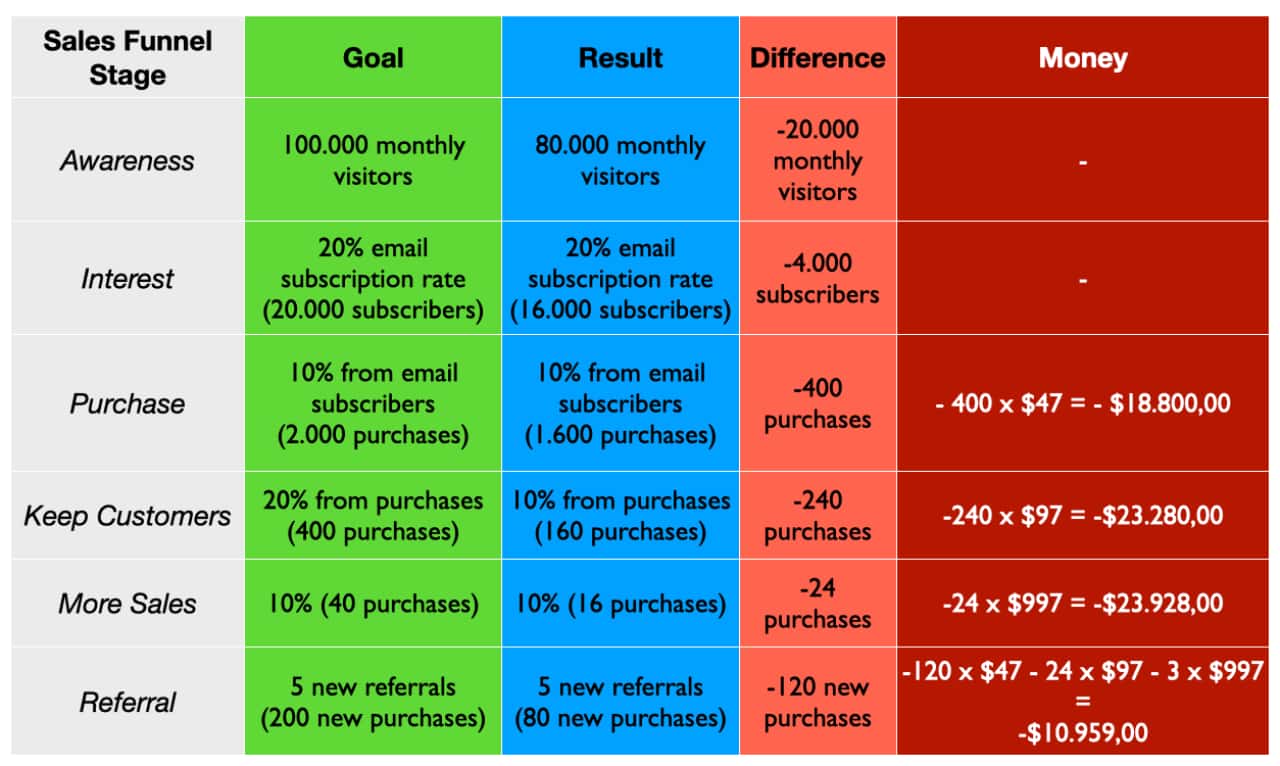
3. Track the results for each KPI
Without knowing the outcome of each of these stages, it is very difficult to know if your business is making progress or not. To help your business measure the effectiveness of each of your stages, you need to follow each KPI. For example, if your goal is to increase website traffic, you want to track the number of new visitors, the number of visitors who complete the transaction, and the amount of money you earned.
The problem comes when you realize that you need to keep track of the results for each of those KPIs. Not only do you have to figure out which one of those KPIs is driving the most success for your business, but you also have to determine which ones are producing the best results.
If you measure the results of your funnel, you will have conversion rates for each stage. Here is an example for the left side of the sales funnel.
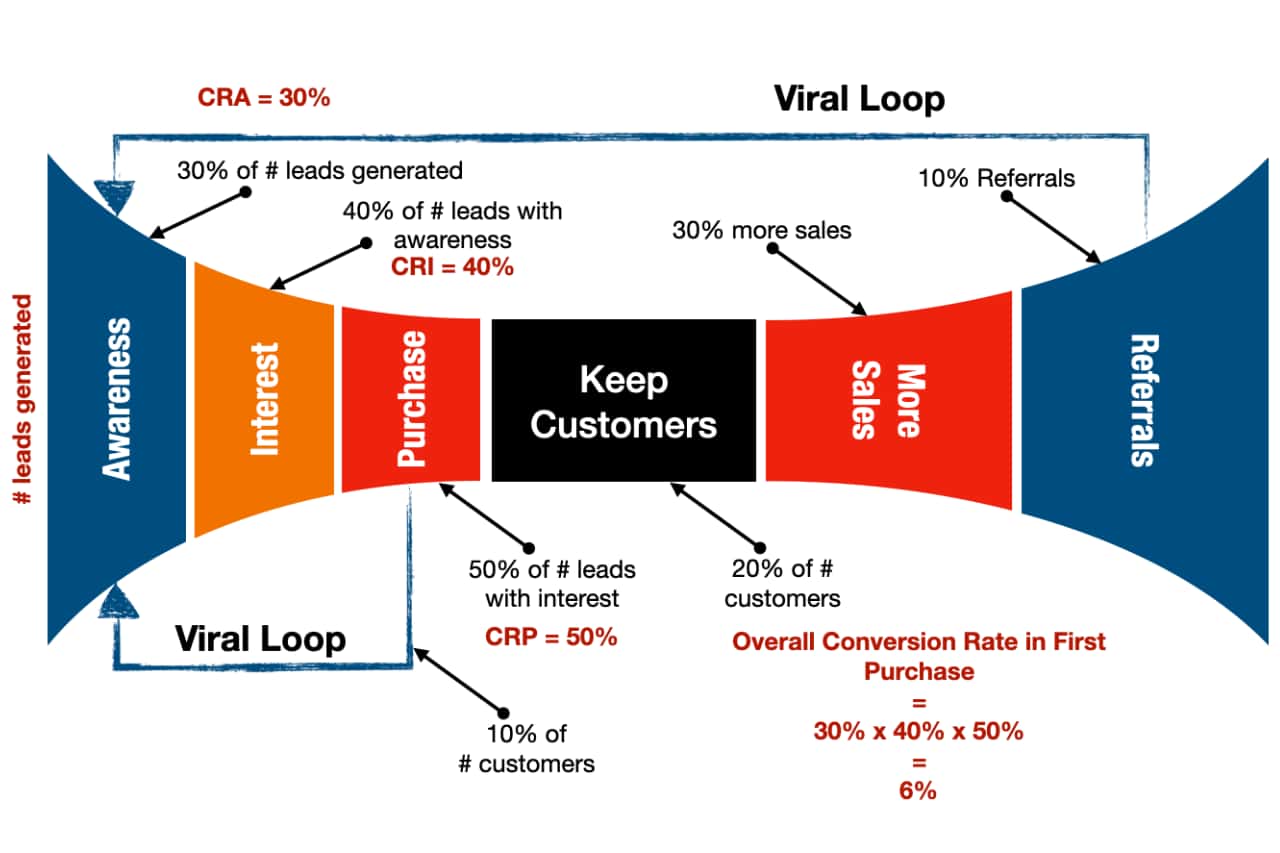
Learn what you’re doing well and where you need to improve
What are the activities that lead to conversion? What steps are needed to turn those activities into conversions? You’ll need to answer these questions as you build your sales funnel. They can help you determine which parts of your business are working and which parts need improvement.
You need to learn what you’re doing well and where you need to improve. So, how will you do this?
As discussed in the previous step, the solution is in your data records and tracking the results. Here is an example of the goals and results for all funnel stages.
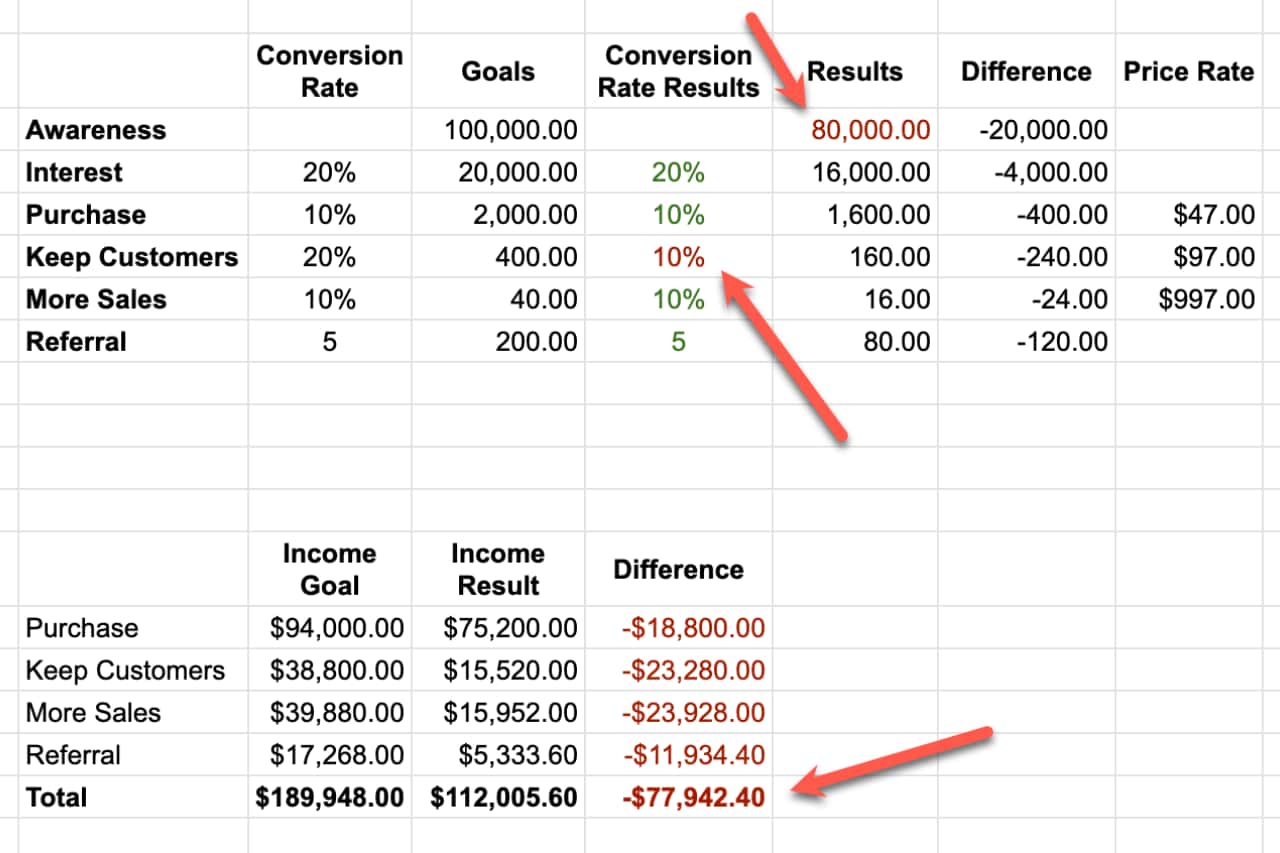
As you can see, we have goals and results. The goal for the awareness stage is to bring 100K visitors to our webpage in a specific period. The result is 80K visitors, so the red color tells us that there is something wrong.
Regarding the interest stage, we achieved what we wanted with the conversion rate, but because we failed to achieve the goal with the awareness stage, we have 16K interested leads instead of 20K, which was our goal. The same thing is happening in the purchase stage. Although we achieved the goal, we still have 400 fewer customers than our goal. In financial terms, if the price rate for the purchase stage is $47, we lose almost $19K potential income.
Keeping customers is also something where we fail. We have a 10% conversion rate instead of 20%, which was our goal. So, here we lost 240 customers or $23,280.00 if the price rate for keeping customers is $97.
If we continue with the more sales and referral stages where we achieve the goal with conversion rates, we will continue to generate less income than planned because of the failures in previous stages. In the end, we will generate $112,005.60 instead of $189,948.00. So, we have more than $77k less income than what was our goal.
This will tell us that there is something wrong and we need to improve it.
But what is wrong? What do we need to improve? Where to focus our attention?
1. Awareness Stage Improvement
You will need to expand your database with all tactics in each funnel stage to answer these questions.
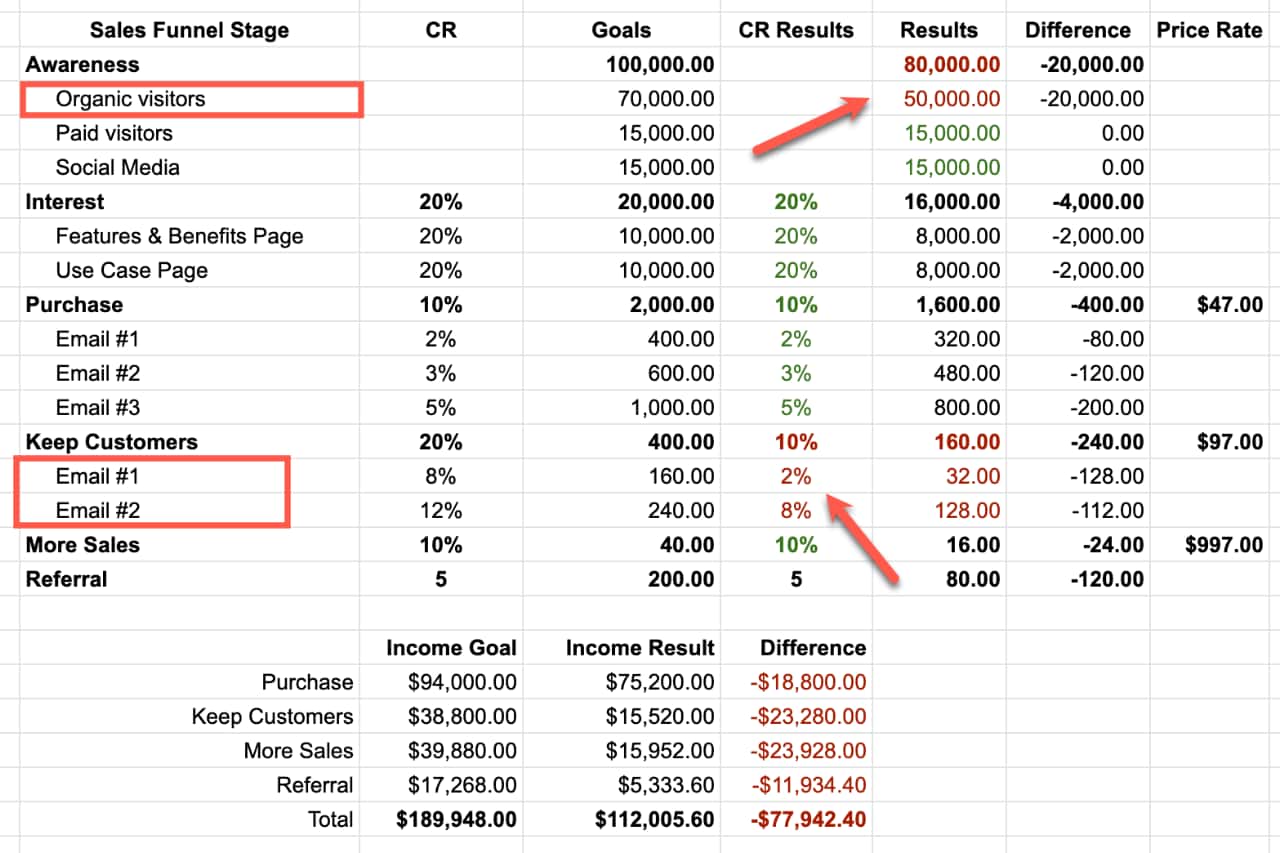
As you can see, now you can quickly locate what you are doing wrong. We don’t have problems with paid visitors and visitors from social media. The problem comes from visitors that come organically to our website. You will probably need to open Google Search Console and look at the CTR (Clickthrough Rate) to check what you need to improve to increase this number.
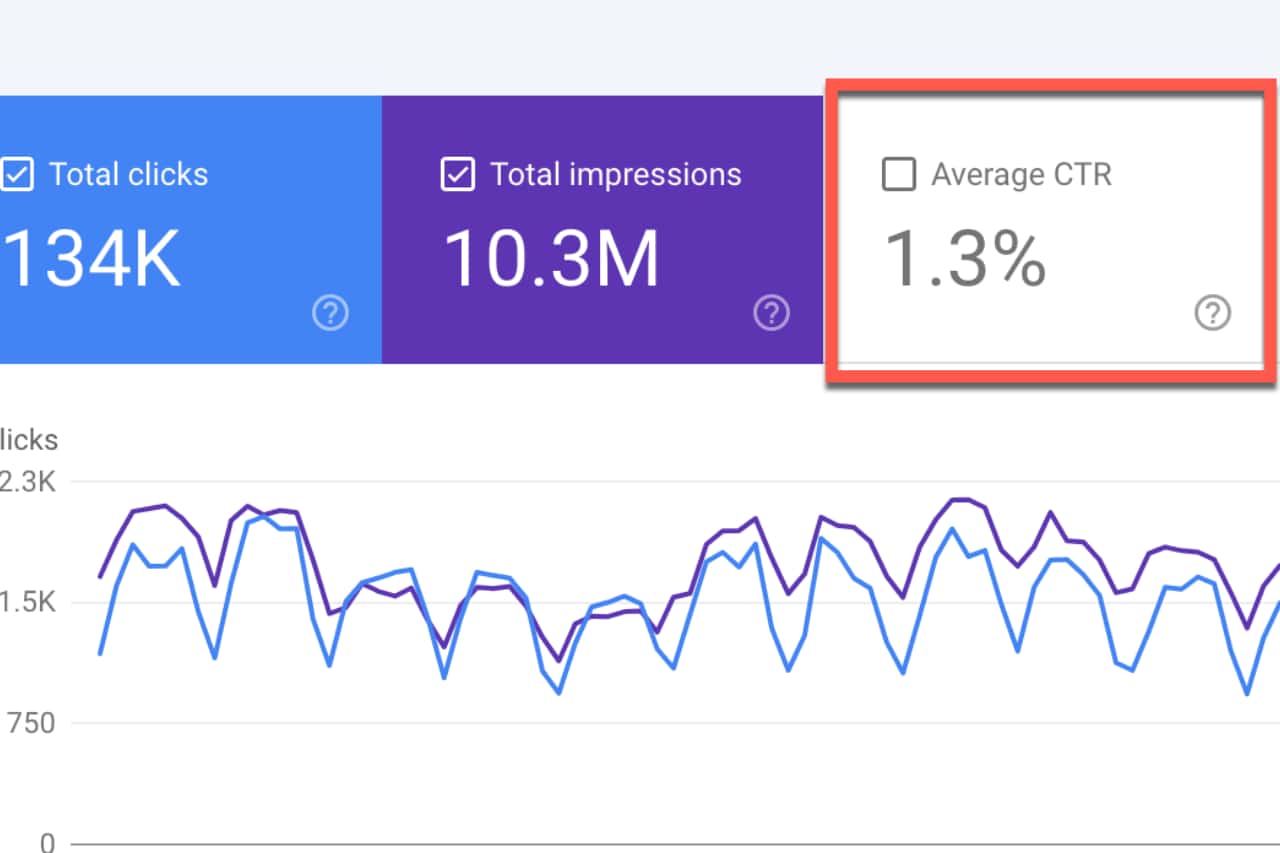
Next, you will need to look at the landing pages on search results with the lowest CTR and relatively strong impressions. As you can see from the example below, if we improve CTR to 2% for the first, third, and fourth page with more than 300K impressions, we will get more than 6600 visitors instead of 179, as in the case with these pages.
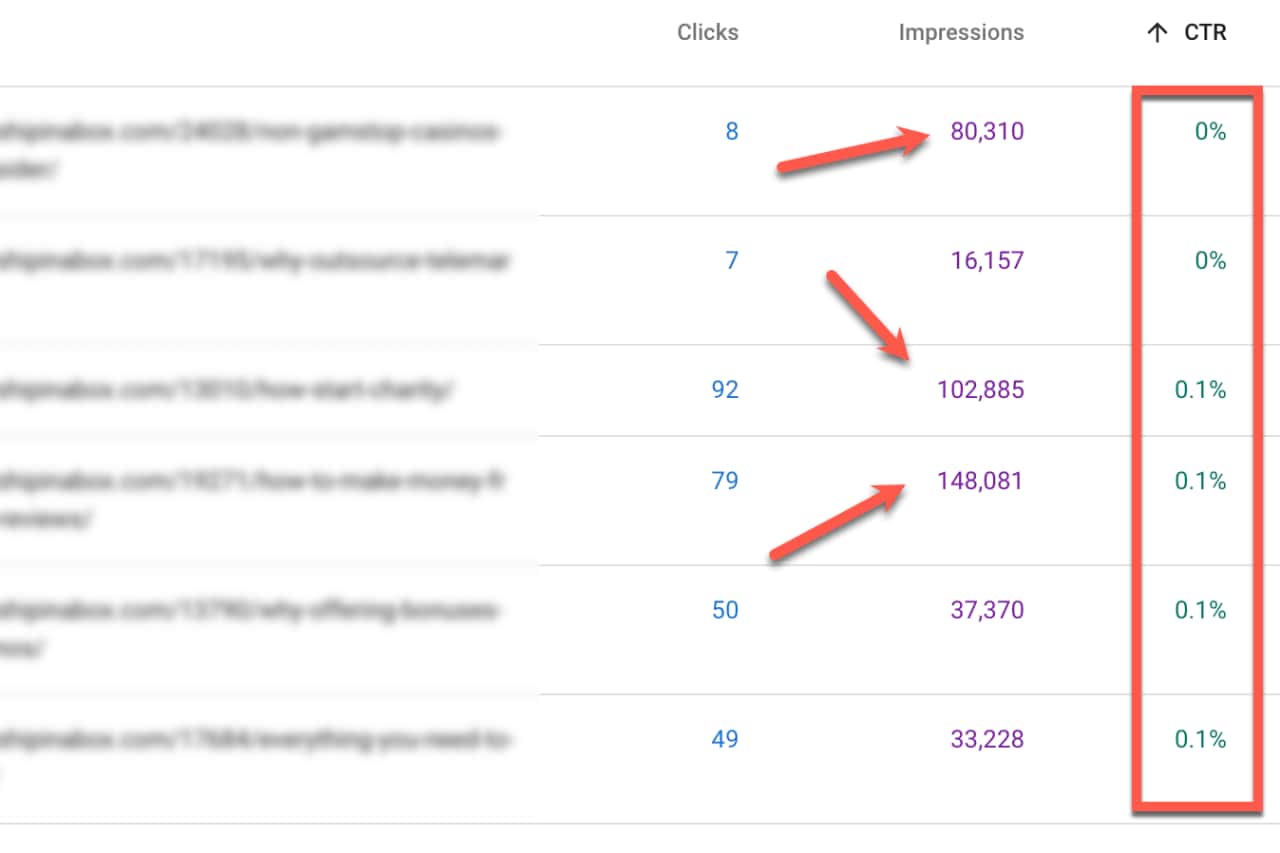
You will need to go through these pages to improve the content, title, meta description, and call to action.
If you are using WordPress, you can easily play with different meta tags using Yoast SEO plugin.
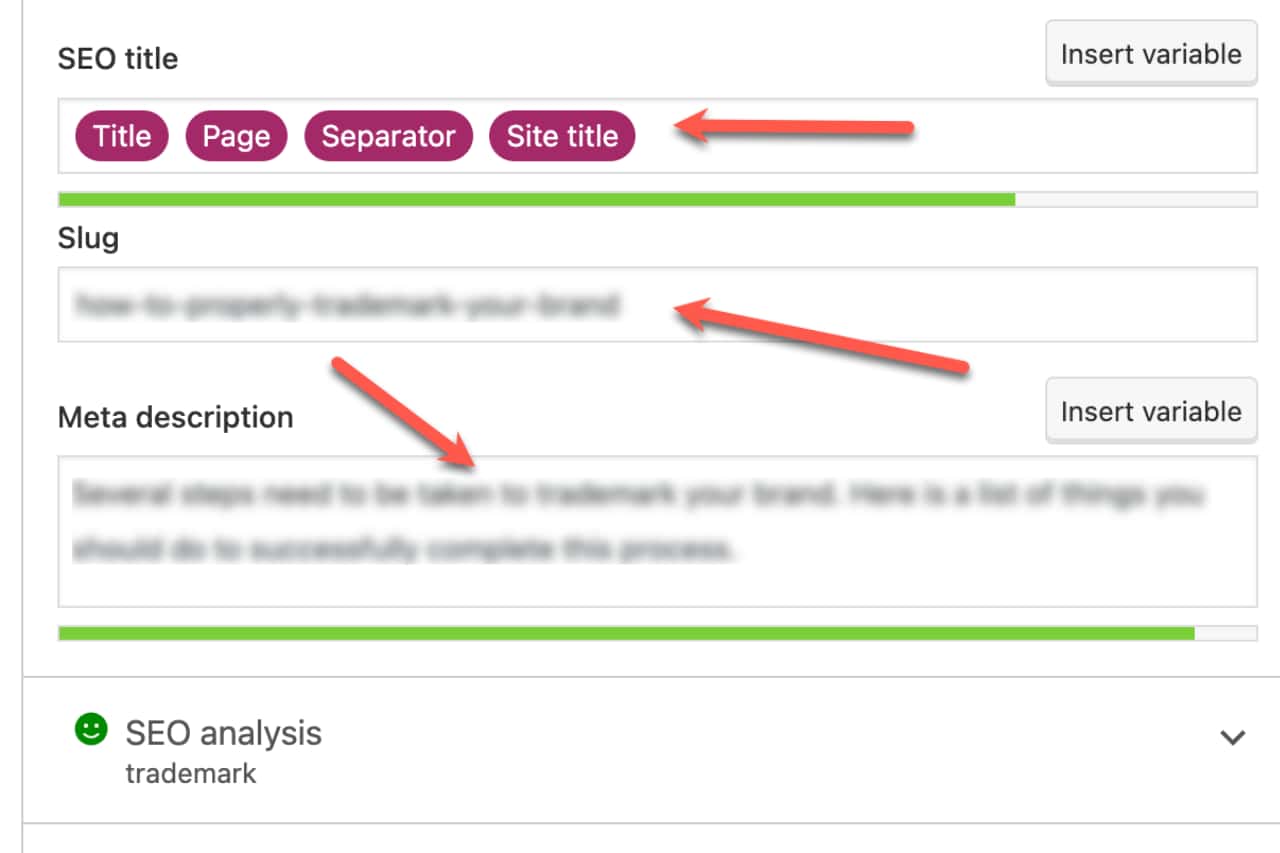
When you finish with the improvement, follow the results in the next period while you work on improvements on other pages.
2. Keep Customers Stage Improvements
You will need to do the same thing with the next problematic area in your sales funnel. Think about increasing the open rate of emails you are sending and CTR. You can change the subject line and call to action inside your email. Use A/B testing with different subject lines to find out what will bring higher open rates. Do the same thing regarding the call to action.
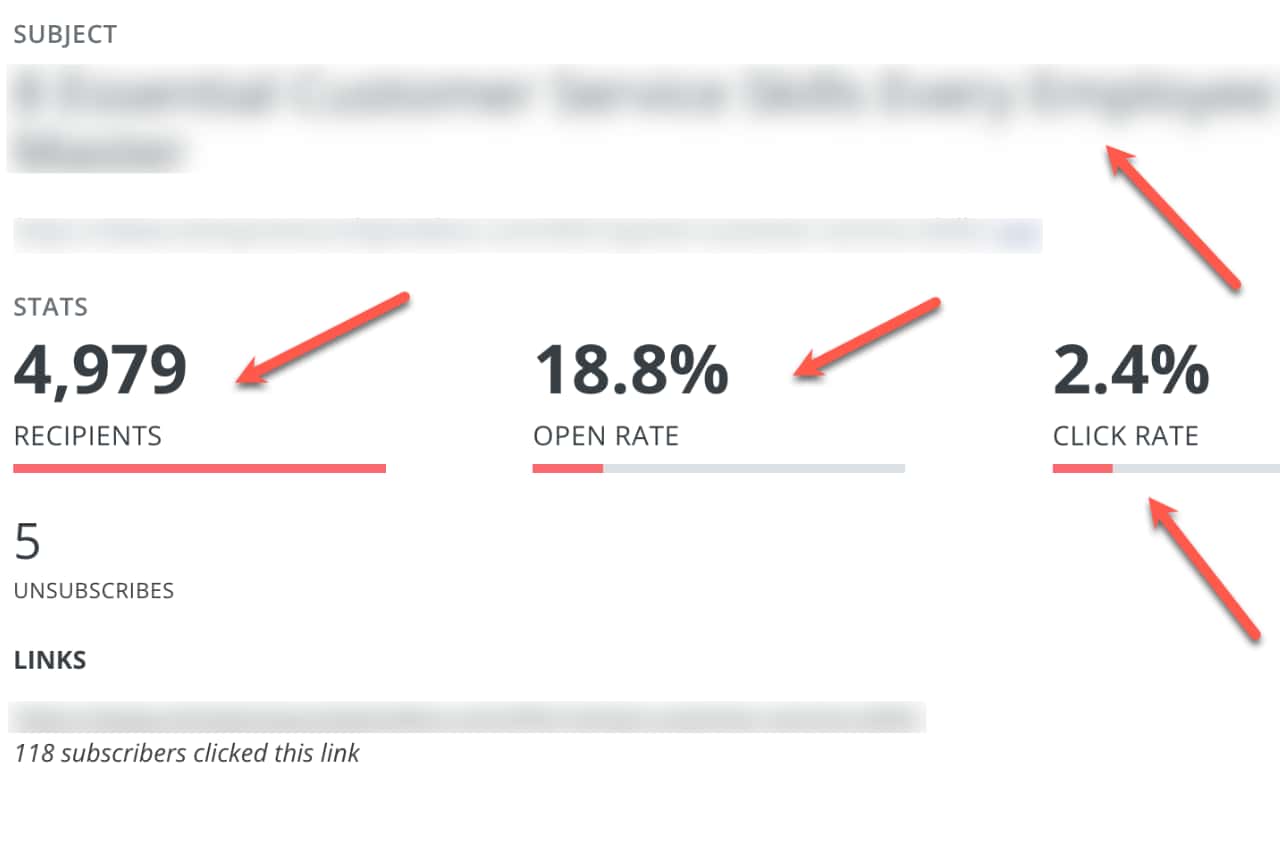
Remember to continuously record data inside Excel or Google Sheets because you want to compare them and select the best possible option. This is a continuous improvement process. Don’t be disappointed if your results aren’t like you planned initially. It is normal. But, it is not allowed not to improve them as you go.
So, never stop experimenting with your sales funnel and work on performance improvements using data analysis.
We have created the sales funnel template that you can download for free.

